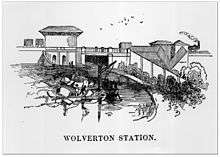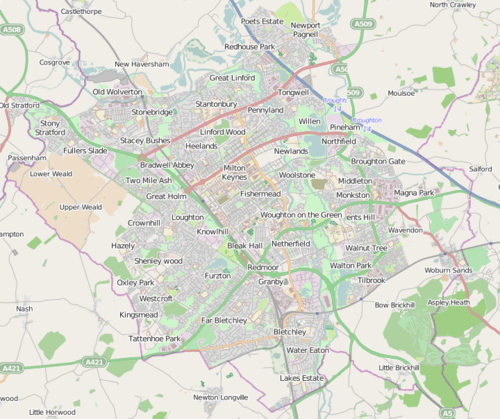Wolverton railway station
Wolverton railway station serves northern Milton Keynes, Buckinghamshire, especially Wolverton, Stony Stratford, New Bradwell, and nearby villages in south Northamptonshire. The station is on the West Coast Main Line, about 52 miles (84 km) from Euston, between Milton Keynes Central and Northampton. The station is one of the six stations serving the Milton Keynes urban area.[lower-alpha 1]
| Wolverton | |
|---|---|
| Location | |
| Place | Wolverton |
| Local authority | Borough of Milton Keynes |
| Grid reference | SP820415 |
| Operations | |
| Station code | WOL |
| Managed by | London Northwestern Railway |
| Number of platforms | 4 |
| DfT category | E |
| Live arrivals/departures, station information and onward connections from National Rail Enquiries | |
| Annual rail passenger usage* | |
| 2014/15 | |
| 2015/16 | |
| 2016/17 | |
| 2017/18 | |
| 2018/19 | |
| History | |
| Key dates | Opened 1881 |
| September 1838[1][2] | First Wolverton station opened by L&BR |
| November 1840[2] | Station rebuilt to a larger design to the south of Stratford Road |
| 1881[1] | Station rebuilt for a second time |
| National Rail – UK railway stations | |
| * Annual estimated passenger usage based on sales of tickets in stated financial year(s) which end or originate at Wolverton from Office of Rail and Road statistics. Methodology may vary year on year. | |
The station has four platforms, of which just two (3 and 4) are normally in use.
History

The first station was built for the opening of the London and Birmingham Railway on 17 September 1838, on the embankment just north of the canal above Wolverton Park.[3] It proved to be temporary as the railway company purchased an additional 13.5 acres to the south and chose to build a larger, permanent station there in 1840. The new station included refreshment rooms which employed a full-time staff of 29. A hotel was planned but never built. The waiting room was lavishly redecorated for the visit of Queen Victoria in 1844, who spent that Christmas as the guest of the Duke of Buckingham and Chandos. In 1881 the main line was re-routed a little to the east (see 'Wolverton bend' below) to allow for expansion of the Wolverton Works and a new station built.[3] The booking hall was a wooden building at street level above the railway line and passengers could reach the platforms via flights of stairs.
The wooden station stood here for over 100 years until British Rail demolished it in 1991.
For many years after the wooden station building was demolished, Wolverton railway station was a temporary shed in the car park at track level. A new brick building to replace it was finally opened on 21 June 2012.[4] The new building is also at track level.
In mid September 2012, the Transport Minister Norman Baker announced in a written answer that the Government had approved London Midland's request to reduce the opening hours of the new ticket office, from the previous 06:00 – 12:00 to 06:15 – 11:00 henceforth.[5]
In 2016, a coffee and snack kiosk opened in the new station booking hall.
Wolverton bend and Northampton Loop
With the advent of fast trains, Wolverton gained notoriety among railwaymen for its famously tight curve. The curve was a result of the station and main line being moved eastward in 1881, to permit extension of the Wolverton Works. The path of the original route is visible at both the north and south ends of the divergence. The Advanced Passenger Train failed its trials here in the early 1990s but the Pendolino tilting trains passed them in the early 2000s. Near the station, the track crosses the valley of the Great Ouse on a viaduct. Slightly further north, the Northampton loop leaves the main line at Hanslope Junction.
Newport Pagnell Branch Line (closed)
From 1865 to 1964, there was a branch line from Wolverton to Newport Pagnell, primarily for employees of Wolverton Works. In 1964 the line was closed to passengers by the Beeching cuts and freight ceased in 1967. Between 1817 and 1864, the section from Great Linford to Newport Pagnell was an arm of the Grand Junction Canal which was then drained to become the track-bed. The route from Wolverton to Newport Pagnell is now a redway. Along the redway, the platforms at New Bradwell and Great Linford are still in place, as are a signal post at Newport Pagnell and an iron bridge taking the line (now the redway) over the Grand Union Canal.
Services
Wolverton is served by trains operated by London Northwestern Railway. The typical off-peak service is:
- 2 tph to London Euston
- 1 tph to Rugeley Trent Valley
- 1 tph to Rugeley Trent Valley and Crewe dividing at Birmingham New Street
| Preceding station | Following station | |||
|---|---|---|---|---|
| Northampton | London Northwestern Railway Northampton loop |
Milton Keynes Central | ||
| Historical railways | ||||
| Castlethorpe Line open, station closed |
London and North Western Railway West Coast Main Line |
Bletchley Line and station open | ||
| Disused railways | ||||
| Bradwell Line and station closed |
London and North Western Railway Wolverton to Newport Pagnell Line |
Terminus | ||
Platforms
The station has four platforms, of which just two are normally in use. Platforms 1 and 2 are the 'fast' lines and trains very rarely stop here: they are used by London Northwestern only during works and Avanti West Coast in emergency. Platforms 3 and 4 are used frequently by London Northwestern: Avanti West Coast services pass these platforms (without stopping) only during works.
Location

The station is at the eastern end of Wolverton, near the junction of Stratford Rd with Grafton Street. The nearest post-code is MK12 5FR.[6] In the chainage notation traditionally used on the railway, its location on the line is 52 miles 33 chains (52.41 mi; 84.35 km) from Euston.[7]
See also
Stations in and around Milton Keynes | |||||||||||||||||||||||||||||||||||||||||||||||||||||||||||||||||||||||||||||||||||||||||||||||||||||||||||||||||||||||||||||||||||||||||||||||||||||||||||||||||||||||||||||||||||||||||||||
|---|---|---|---|---|---|---|---|---|---|---|---|---|---|---|---|---|---|---|---|---|---|---|---|---|---|---|---|---|---|---|---|---|---|---|---|---|---|---|---|---|---|---|---|---|---|---|---|---|---|---|---|---|---|---|---|---|---|---|---|---|---|---|---|---|---|---|---|---|---|---|---|---|---|---|---|---|---|---|---|---|---|---|---|---|---|---|---|---|---|---|---|---|---|---|---|---|---|---|---|---|---|---|---|---|---|---|---|---|---|---|---|---|---|---|---|---|---|---|---|---|---|---|---|---|---|---|---|---|---|---|---|---|---|---|---|---|---|---|---|---|---|---|---|---|---|---|---|---|---|---|---|---|---|---|---|---|---|---|---|---|---|---|---|---|---|---|---|---|---|---|---|---|---|---|---|---|---|---|---|---|---|---|---|---|---|---|---|---|---|
| |||||||||||||||||||||||||||||||||||||||||||||||||||||||||||||||||||||||||||||||||||||||||||||||||||||||||||||||||||||||||||||||||||||||||||||||||||||||||||||||||||||||||||||||||||||||||||||
- Wolverton railway works
- Wolverton and Stony Stratford Tramway
- Denbigh Hall railway station: Pending construction of a viaduct over the River Ouse, passengers alighted at Denbigh Hall and transferred to coaches on the London-Birmingham turnpike.
References
- Wolverton Society for Arts and Heritage – Accessed 7 December 2007
- Mapley family history – Accessed 7 December 2007
- Wolverton: From Aqueduct to Viaduct – Milton Keynes Heritage Association
- Mayor reveals plaque at Wolverton train station – Milton Keynes Citizen, 28 June 2012
- MPs defend reduction in train ticket office opening hours – Milton Keynes Citizen, 18 September 2012
- Streetmap.co.uk
- Engineer's Line References RailwayCodes.org
Notes
- The others are Milton Keynes Central, Bletchley, Fenny Stratford, Bow Brickhill, and Woburn Sands
External links
- Train times and station information for Wolverton railway station from National Rail
- Pendolino rounds Wolverton bend (before coming to a stop at Milton Keynes Central)
